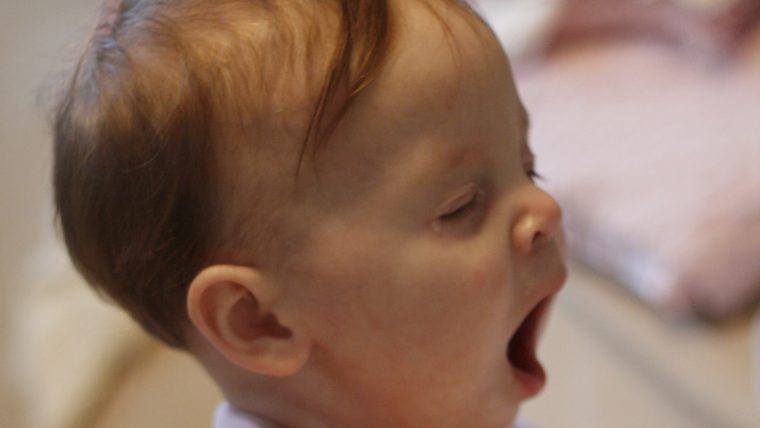
When baby fights naps
Like many respectful parents, I started out “baby-led.” That is, I did what my newborn son wanted to do, whenever he wanted to do it. This seemed like the most respectful—and healthiest—way to manage our time. After all, why should my son be on anyone else’s timetable? I wanted him to be in touch with his needs, and to learn that I would be there reliably to meet his needs as soon as he expressed them.
It was all good…until he turned into a 4 month old who wouldn’t nap.
(Sound familiar? This happens to a lot of babies around age 3-4 months. Younger babies tend to be fine regulating their own sleep, but around this age sometimes they start to have a harder time.)
I knew my son was supposed to be staying up for about 90 minutes at a time, but he was fighting sleep, staying up for too long, and showing signs of being overtired and overstimulated.
I read about putting him down at the first sign of sleepy cues. I read about the “magic sleep window” that happens right at 90 minutes, where supposedly you can put your baby in bed and he or she will miraculously drift off to sleep because you got the timing perfectly right. It didn’t work—no matter whether I put him down at 75 minutes, 90 minutes, or 2 hours or more, he always fought it.

I wasn’t even trying to make him sleep in a crib. Carrier, swing, nursing, in my arms while being bounced on a yoga ball—wherever you want to sleep, little guy, it’s fine! Just sleep! Nope. No such luck.
I knew sleep was important. How, I wondered, could I help my baby get the rest he needed? Of course I couldn’t force him to sleep. But clearly, just offering him an opportunity to sleep was not good enough.
What I really wanted was a way to encourage him to sleep, but he was too young to understand my words clearly. Of course, I could talk to him about the importance of getting rest—and, believe me, I did—but I wanted a better way to connect with him, to send the message, “It’s really time to rest now,” in a way he would understand.
Enter…the routine.
A routine is, in its essence, a sequence of steps that never vary—like a ritual. To have a routine is to make a commitment to doing things the same way every time. A routine can help with getting on a schedule, but it doesn’t need to go along with a strict schedule; the timing can still be flexible and responsive to everyone’s needs.
Here’s why routine is so useful. Very young babies can understand it. They can learn sequences—one thing that always comes after another, and another after that. It occurred to me that starting a consistent routine would be a very clear way of telling my son, “All right, it’s time to wind down and get ready to rest.” When I started the routine, he would know that it was not time to sleep right that instant but that it would be soon. He could relax and prepare.
That’s the other thing about routine: it’s boring. It’s the opposite of novelty and stimulation. Routines help us slow down, calm down, and focus on our internal thoughts, feelings. and sensations.
Obviously, this calming quality is especially valuable in preparing for sleep, because it’s much easier to get to sleep if you can reduce stimulation and calm yourself down. That’s why “Implement a bedtime routine!” is baby sleep hygiene 101. Routines can help with naps, too, and even with other situations where we need to focus on our bodies and our needs—for example, at mealtime, to help a busy child who is engaged with exciting games or other stimulation calm down and realize that she is feeling hungry.
Some babies do fine without routines, because they can always tell when they need something. These are the babies who can fall asleep in the middle of playing. For other children—like my son—it is not so easy to screen out what is going on and listen to their bodies, and especially difficult to wind down when it’s time to sleep. These are the children who especially benefit from routine, because it’s a great reminder to them to calm down, focus inward, and take care of their bodily needs. This is also why 3-4 months, when babies are becoming so much more aware of the world, is often the time when routine can really become useful.
Putting together a routine
I started thinking about what kind of routine I should use with my son. The full routine should be about as long as it takes to calm down enough, and that’s a duration that varies by child. Children who have a harder time winding down can sometimes benefit from a longer routine, but you also don’t want to make it so long that the child starts to get squirrelly. When I came up with our routine, I aimed for about 5-10 minutes.
It doesn’t really matter what you do in your routine as long as it’s non-stimulating and very consistent. At the time, I was having the most consistent luck getting my son to sleep in the swing immediately after nursing—and I wasn’t yet comfortable letting him cry much—so I based our routine around nursing him and then putting him in the swing. I’d been trying that among many other things at nap time to try to get him to nap, but instead of just trying it as one technique among many, I planned to do it every time.
It’s also helpful to have elements of the routine that are unique to that routine—again, to send an unmistakable message about what is coming next. In our case, nursing was something that my son did often, not just at naptime, so I added a few things to make it clearly a nap routine: before nursing, I sang a special nap time song (only used at nap time, so he knew for sure that a nap was coming), I turned off the light, and then I nursed him in a different spot on the couch from where I did at other times. I also introduced a lovey—I chose a soft, simple little blanket (and bought multiples!), and I gave it to him to play with as he nursed. Now two years old, he still has his blankie at each nap and at bedtime.
All of these special markers were things that he could start to associate purely with naps, so that, once he learned the routine, he could let his body start to relax, knowing that rest time was coming.
Introducing a routine
Learning a routine is complicated. It’s not just about the first or the last activity in the sequence; it’s about the entire sequence, as a whole. This means that, in introducing a routine, parents have to be incredibly consistent and repetitive with the entire sequence to ensure that the child is getting the message.
I knew that it would take time for my son to learn our new routine, and that I would have to be super consistent. I was staying home with him full time, so I didn’t have firm obligations during the day, which made it easier. I decided to make the nap routine my top priority until it was going smoothly.
This did limit my flexibility, but it wasn’t a hard choice to make given the frustration and the fights that we were currently experiencing around trying to get him to nap!
Remember, the important thing is for the entire routine, from start to finish, to precede going to sleep (or eating or whatever the routine is a preparation for). So what you need to focus on is making sure that every time your baby naps, the nap comes right after every single step in the sequence, in order.
Of course, there is nothing magical about just having a routine—the magic is in the predictability and the association. So, at first, my son didn’t get it. I sang, I turned off the light, I nursed in the special nap place, and I put him in his swing… and at first his reaction was basically: “Um, what?!”
But I knew to expect that reaction. I didn’t fight him. My only goal was to have him nap right after the routine.
So, when it became clear that he wasn’t going to fall asleep, I turned the light back on and went back to playing, and I waited for the next opportunity to try again. (I generally waited about half an hour or until I saw sleepy cues, whichever came first.) When it was time to try again, I did the entire routine from start to finish and then tried to put him down.
At first I would have to do the routine five times or more before he would go to sleep. But I made sure that whenever he did go to sleep, it was after the routine. And, gradually, he started falling asleep after fewer and fewer times. He was catching on—he was starting to understand that the routine meant nap time.
Several days later—if you’re introducing a new routine, give it about a week or two—my son was falling asleep after much more appropriate awake times, and he was getting overstimulated less often. Our nap time fights had gone down dramatically. Things weren’t perfect, but they were so much better!
Routines are respectful
I think routines have a bad reputation in the gentle parenting world. They are seen as being primarily for the sake of the adults, as a way for adults to force children into unnatural but convenient schedules.
Don’t make the mistake of thinking that being baby-led about everything is the only way to be respectful. If you are a respectful parent who is having trouble helping your child get enough rest, routines are an invaluable tool to have in your arsenal! They are not always just a way for adults to call the shots; they are also predictable, calming, and easy for even the youngest children to understand. Not all children need them, but for some they are a lifesaver, the best way to focus on meeting their needs in the middle of an exciting world full of engaging distractions. And they are a great way to encourage more regular sleep habits without any tears or protest whatsoever.
If you are ready to implement a new routine with your little one, remember to be incredibly consistent, and give it time. With any luck, your days will soon be going much more smoothly!

Leave a Reply